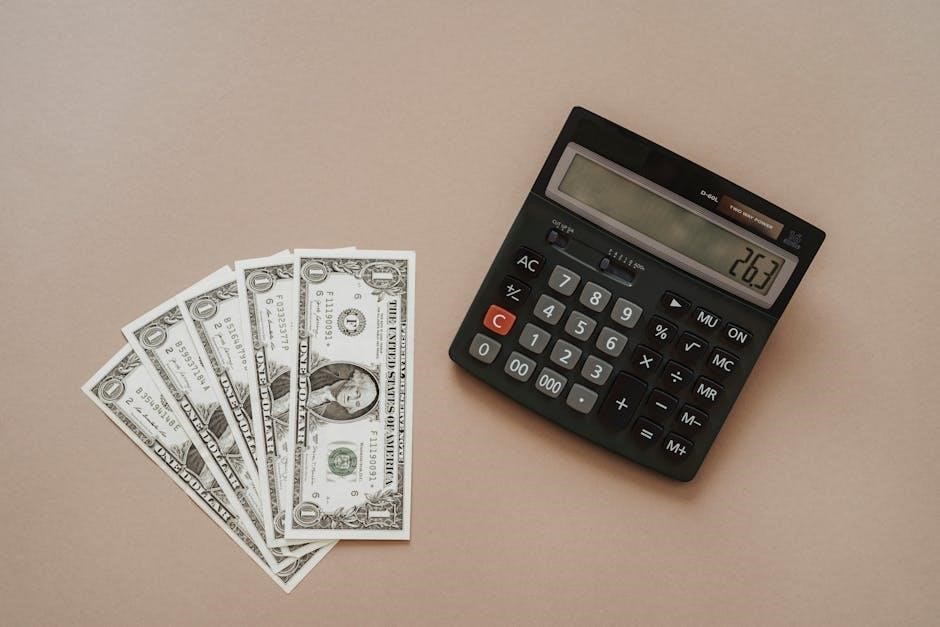Boundaries are crucial in recovery‚ aiding mental and emotional well-being. Worksheets help identify areas needing limits‚ fostering a structured approach to healing and personal growth.
1.1 Defining Boundaries and Their Importance in Recovery
Boundaries are clear limits that define emotional‚ mental‚ and physical expectations in relationships. In recovery‚ they are essential for protecting mental health‚ preventing emotional overload‚ and fostering resilience. By establishing boundaries‚ individuals can avoid triggers‚ maintain healthy relationships‚ and focus on personal growth. Worksheets and exercises help identify areas where boundaries are needed‚ providing a structured approach to implementing and communicating them effectively. This foundation supports long-term recovery and well-being.
1.2 Why Boundaries Are Essential for Mental and Emotional Well-being
Boundaries are vital for safeguarding mental and emotional health‚ especially in recovery. They prevent emotional overload‚ protect against toxic influences‚ and foster resilience. By setting clear limits‚ individuals can manage triggers‚ reduce stress‚ and maintain balance. Healthy boundaries promote self-care‚ self-respect‚ and emotional stability‚ which are critical for long-term well-being. Worksheets and exercises help identify and communicate these limits‚ ensuring a strong foundation for mental health and recovery.

Understanding the Concept of Boundaries
Boundaries are limits set to protect emotional‚ mental‚ and physical well-being. They help individuals maintain healthy relationships‚ personal space‚ and balance during recovery. Worksheets guide their identification and implementation.
2.1 Types of Boundaries: Physical‚ Emotional‚ and Mental
Boundaries are categorized into physical‚ emotional‚ and mental types. Physical boundaries involve personal space and physical contact limits. Emotional boundaries protect feelings and mental energy‚ preventing emotional overload. Mental boundaries safeguard thoughts and beliefs‚ ensuring clarity and focus. Worksheets help identify and define these boundaries‚ fostering awareness and balance in recovery. Each type plays a vital role in maintaining overall well-being and healthy relationships.
2.2 Signs That Boundaries Are Needed
Signs that boundaries are needed include feeling emotionally drained‚ overwhelmed‚ or resentful. You may struggle to say no‚ feel pressured by others’ demands‚ or experience emotional triggers. Physical cues like tension or stress can also indicate boundary needs. Recognizing these signs is crucial for maintaining healthy limits and protecting your well-being. Worksheets can help identify these patterns‚ enabling you to address them effectively and establish necessary boundaries in your recovery journey.
2.3 How Boundaries Differ from Isolation
Boundaries and isolation are often confused but serve different purposes. Boundaries involve setting healthy limits to protect your emotional and mental well-being‚ fostering respect and intimacy. Isolation‚ however‚ involves disconnecting from others‚ potentially leading to loneliness. Unlike isolation‚ boundaries promote mutual respect and understanding. Worksheets can help clarify this distinction‚ ensuring you establish boundaries that enhance relationships rather than create distance. This balance is vital for sustainable recovery and personal growth.
Identifying Boundaries in Recovery
Recognizing personal boundaries is key to emotional safety and balance in relationships. Worksheets guide individuals in assessing current limits‚ identifying gaps‚ and fostering accountability in their recovery journey.
3.1 Assessing Current Boundaries
Assessing current boundaries involves evaluating physical‚ emotional‚ and mental limits. Worksheets help identify where boundaries are clear or lacking‚ encouraging reflection on past experiences and triggers. By recognizing patterns‚ individuals can pinpoint areas needing adjustment‚ fostering accountability and clarity in their recovery process. This step is foundational for setting healthy boundaries and promoting emotional resilience.
3.2 Recognizing Areas Where Boundaries Are Lacking
Recognizing gaps in boundaries requires self-reflection and awareness. Worksheets guide individuals to evaluate relationships‚ emotions‚ and physical spaces‚ identifying where limits are absent. Common signs include emotional triggers‚ overcommitting‚ or feeling drained. By pinpointing these areas‚ individuals can address vulnerabilities‚ fostering healthier dynamics and emotional resilience. This step is vital for recovery‚ enabling individuals to reclaim control and establish boundaries that align with their needs and well-being.
3.3 Using Worksheets to Identify Personal Boundaries
Boundary worksheets provide a structured approach to identifying personal limits. They guide individuals to assess emotional‚ mental‚ and physical boundaries‚ helping pinpoint areas needing attention. Exercises include listing triggers‚ defining needs‚ and creating “I need” statements. These tools promote clarity and self-awareness‚ empowering individuals to set healthy boundaries. Regular use of worksheets fosters personal growth and strengthens boundary-setting skills‚ essential for long-term recovery and emotional resilience.

Setting Healthy Boundaries
Setting healthy boundaries involves clear communication and defining personal limits. Worksheets and action plans help maintain these boundaries‚ ensuring they are respected and aligned with recovery goals.
4.1 Communicating Boundaries Effectively
Effective communication is key to setting healthy boundaries. Using “I need” statements clarifies personal limits without blame. Active listening ensures mutual understanding‚ fostering respect in relationships. Practicing boundary conversations through role-playing exercises builds confidence. Worksheets and templates provide structured guidance‚ helping individuals articulate their needs clearly and assertively‚ ensuring boundaries align with recovery goals and promote emotional well-being.
4.2 Creating a Boundary Action Plan
A boundary action plan outlines clear steps to establish and maintain healthy limits. Start by identifying specific boundaries needed‚ then define actionable strategies to implement them. Use worksheets to list triggers and corresponding responses‚ ensuring accountability. Regularly review and adjust the plan to reflect progress in recovery. This structured approach helps individuals stay committed to their boundaries‚ fostering resilience and emotional stability over time.
4.3 Using “I Need” Statements to Define Boundaries
“I need” statements are a powerful tool for clearly communicating boundaries. They focus on personal requirements‚ reducing conflict and misinterpretation. For example‚ “I need personal space” or “I need time to process emotions.” Worksheets often include these statements to help individuals articulate their needs effectively. This approach fosters respect‚ accountability‚ and emotional safety‚ making it easier to uphold boundaries in recovery and daily life.

Enforcing and Maintaining Boundaries
Consistently enforcing boundaries requires clear communication‚ consequences‚ and self-awareness. Worksheets help track progress‚ ensuring boundaries remain effective as recovery evolves and new challenges arise.
5.1 Strategies for Upholding Boundaries
Effective strategies for upholding boundaries include using “I need” statements‚ setting clear consequences‚ and regularly tracking progress with worksheets. Prioritize self-care‚ protect physical and emotional space‚ and practice assertive communication. Consistency is key to maintaining healthy limits‚ ensuring personal well-being and fostering respectful relationships. Worksheets can also help identify triggers and develop actionable plans to address boundary challenges proactively.
5.2 Handling Challenges When Boundaries Are Tested
When boundaries are challenged‚ remain calm and assertive‚ using “I need” statements to reinforce limits. Practice active listening to understand others’ perspectives while maintaining your position. Use boundary worksheets to identify triggers and prepare responses. Reflect on challenging situations to refine strategies and strengthen emotional resilience. Consistency and self-care are vital to navigating conflicts and upholding personal boundaries effectively in recovery.
5.3 Adjusting Boundaries as Recovery Progresses
As recovery advances‚ boundaries may need refinement to reflect personal growth. Regularly review and assess current limits‚ using worksheets to track changes. Stay flexible‚ adjusting boundaries to align with new insights and emotional resilience. Document progress to identify areas where adjustments are necessary. Prioritize self-care and openness to change‚ ensuring boundaries remain supportive and adaptive throughout the recovery journey.

Practical Exercises for Boundary Setting
Engage in exercises like boundary identification worksheets‚ role-playing‚ and journaling to practice setting limits. These tools help clarify and communicate personal boundaries effectively in recovery.
6.1 Boundary Identification Worksheets
Boundary identification worksheets are tools designed to help individuals recognize areas where limits are needed. They guide users to assess current boundaries‚ define necessary restrictions‚ and evaluate their effectiveness. These worksheets often include prompts to identify emotional‚ mental‚ and physical limits‚ fostering clarity and structure in boundary setting. By systematically analyzing personal needs and triggers‚ individuals can create a clear roadmap for establishing healthy boundaries in recovery.
6.2 Role-Playing Exercises for Boundary Communication
Role-playing exercises provide a safe space to practice boundary communication. Participants act out scenarios where boundaries are challenged‚ helping them develop assertiveness and confidence. These exercises often involve using “I need” statements to clearly express limits. By rehearsing responses to common boundary-testing situations‚ individuals can refine their communication skills and feel more prepared to enforce boundaries in real-life recovery contexts‚ fostering healthier interactions and personal growth.
6.3 Journaling Prompts for Reflecting on Boundaries
Journaling prompts help individuals reflect on their boundaries‚ fostering self-awareness and clarity. Questions like “What triggers the need for a boundary?” or “How did I feel after setting a limit?” encourage deeper insight. Writing about past boundary experiences and their outcomes can also guide personal growth. These exercises allow individuals to explore their needs‚ identify patterns‚ and develop healthier boundary-setting habits‚ enhancing their recovery journey and emotional well-being over time.

Relapse Prevention and Boundaries
Boundaries play a vital role in preventing relapse by protecting emotional and mental stability. They help individuals avoid triggers and maintain healthy limits‚ ensuring sustained recovery and well-being.
7.1 How Boundaries Prevent Emotional Relapse
Boundaries act as a protective shield against emotional triggers that can lead to relapse. By setting clear limits‚ individuals can recognize and manage overwhelming emotions early‚ preventing escalation. Healthy boundaries help maintain emotional stability‚ reduce stress‚ and promote self-care. They also foster accountability and self-awareness‚ essential for sustained recovery. Worksheets and exercises‚ like identifying personal triggers‚ further enhance this process‚ ensuring individuals stay grounded and focused on their mental well-being.
7.2 Using Boundaries to Avoid Triggers
Boundaries play a vital role in avoiding triggers by creating emotional and mental space. They help individuals recognize and respond to situations that may lead to relapse. By setting clear limits‚ people can protect themselves from environments or behaviors that provoke stress or anxiety. Worksheets and exercises‚ such as trigger identification lists‚ empower individuals to anticipate and avoid harmful scenarios‚ fostering resilience and stability in recovery. This proactive approach strengthens emotional well-being and reduces the risk of relapse.
7.3 Incorporating Boundaries into a Relapse Prevention Plan
Integrating boundaries into a relapse prevention plan is essential for long-term recovery. Worksheets help identify triggers and establish clear limits to avoid harmful situations. By outlining specific boundaries‚ individuals create a protective framework that promotes emotional stability. Regularly reviewing and adjusting these boundaries ensures they remain effective. This structured approach fosters accountability and resilience‚ reducing the likelihood of relapse while encouraging sustainable growth and well-being.

Emotional and Mental Boundaries in Recovery
Emotional and mental boundaries are vital for safeguarding mental health during recovery. Worksheets help identify triggers‚ fostering resilience and protecting mental space to promote emotional stability and growth.
8.1 Managing Emotional Triggers
Emotional triggers can derail recovery if left unaddressed. Worksheets help identify and map triggers‚ enabling individuals to develop coping strategies. Techniques like grounding and mindfulness can reduce reactivity‚ fostering emotional resilience. Setting clear boundaries ensures emotional well-being by limiting exposure to harmful stimuli. By understanding personal triggers‚ individuals can create tailored plans to manage emotions healthily‚ promoting stability and growth in recovery.
8.2 Protecting Mental Space
Protecting mental space is vital for emotional well-being in recovery. Worksheets help identify mental boundaries‚ allowing individuals to limit negative influences and focus on healing. Techniques like mindfulness and time management can safeguard mental energy. By setting clear limits on mental engagement‚ individuals reduce stress and promote self-care. Boundaries ensure mental space is reserved for positive‚ recovery-oriented thoughts and activities‚ fostering a healthier mindset and overall stability.
8.3 Practicing Self-Care as a Form of Boundary Setting
Self-care is a powerful way to establish boundaries‚ ensuring mental and emotional well-being. Worksheets guide individuals in identifying activities that recharge their energy and set limits on draining behaviors. By prioritizing self-care‚ individuals create intentional boundaries‚ protecting their mental space and fostering resilience. Consistent self-care practices‚ such as mindfulness or hobbies‚ reinforce healthy boundaries‚ promoting long-term recovery and emotional stability.

Physical Boundaries in Recovery
Physical boundaries protect personal space and belongings‚ ensuring a safe environment. Worksheets help define limits on contact and access‚ promoting recovery by preventing triggers and stress.
9.1 Setting Limits on Physical Contact
Setting limits on physical contact is vital for maintaining personal space and emotional well-being. Worksheets help individuals define clear boundaries‚ such as specifying acceptable forms of touch or distance. This process ensures comfort and safety‚ reducing stress and anxiety. By establishing these limits‚ individuals in recovery can protect their physical and emotional health‚ preventing triggers and fostering a secure environment for healing. Clear boundaries also promote respect and understanding in relationships‚ aiding long-term recovery goals.
9.2 Protecting Personal Belongings
Protecting personal belongings is a key aspect of setting physical boundaries in recovery. Worksheets can help individuals define clear limits regarding their possessions‚ ensuring respect and privacy. This involves specifying what others can or cannot borrow or use‚ fostering a sense of control and security. By safeguarding personal items‚ individuals in recovery can reduce stress and anxiety‚ promoting emotional well-being. Clear boundaries also help prevent conflicts and maintain healthy relationships‚ which are essential for long-term recovery and personal growth.
9.3 Creating Safe Physical Environments
Creating safe physical environments is vital for recovery‚ as it fosters a sense of security and control. Worksheets can guide individuals in identifying and rearranging their spaces to promote well-being. This may involve decluttering‚ personalizing areas‚ or setting limits on shared spaces. A safe environment reduces stress and emotional triggers‚ aiding in recovery. By establishing clear physical boundaries‚ individuals can protect their privacy and create a space that supports relaxation‚ focus‚ and overall healing.

The Impact of Boundaries on Relationships
Boundaries enhance relationships by fostering respect and understanding. They prevent conflicts and promote emotional well-being‚ ensuring healthy interactions that support recovery.
10.1 Improving Communication in Relationships
Setting boundaries enhances communication by defining emotional and mental limits‚ promoting clarity and honesty. This fosters healthier interactions‚ mutual respect‚ and understanding in recovery relationships.
10.2 Building Respect and Trust
Boundaries foster respect and trust by creating clear limits that protect emotional well-being. When individuals honor each other’s boundaries‚ it demonstrates reliability and mutual understanding. This foundation of respect encourages open communication and strengthens relationships. Worksheets can help clarify these boundaries‚ ensuring they are communicated effectively. By maintaining these limits‚ trust grows‚ and relationships become more resilient and respectful.
10.3 Navigating Conflict When Boundaries Are Established
When boundaries are set‚ conflicts may arise‚ requiring effective navigation. Open communication and active listening are key to resolving disagreements respectfully. Using “I need” statements can clarify expectations without blame. Worksheets can help identify triggers and prepare responses‚ fostering understanding. Addressing conflicts constructively strengthens relationships and reinforces the importance of boundaries in recovery‚ ensuring they remain a tool for healing rather than division.

Worksheets and Tools for Boundary Setting
Worksheets and tools provide structured guidance for setting boundaries‚ helping individuals identify needs and communicate effectively. Templates and trackers support accountability and progress in boundary establishment.
11.1 Boundary Assessment Worksheets
Boundary assessment worksheets are essential tools for evaluating current boundaries and identifying areas needing improvement. They guide individuals in recognizing emotional‚ mental‚ and physical limits‚ promoting self-awareness. By using “I need” statements‚ users can clarify their requirements and establish clear guidelines. These worksheets often include exercises to explore personal values and triggers‚ helping to create actionable plans. Regular use enhances accountability and fosters growth‚ ensuring boundaries align with recovery goals and overall well-being.
11.2 Boundary Setting Templates
Boundary setting templates provide structured frameworks for clearly defining and communicating limits. They often include sections for physical‚ emotional‚ and mental boundaries‚ guiding users to articulate their needs effectively. Templates may incorporate “I need” statements‚ offering examples like “I need personal space” or “I need time to process emotions.” These tools help ensure boundaries are specific‚ measurable‚ and actionable‚ fostering accountability and clarity in recovery. They also allow for customization to suit individual circumstances and growth over time.
11.3 Tracking Progress with Boundary Worksheets
Boundary worksheets are invaluable for monitoring progress in setting and maintaining limits. They allow individuals to reflect on what works and what doesn’t‚ ensuring continuous improvement. By documenting boundaries and their enforcement‚ users can identify patterns and areas needing adjustment. Worksheets often include space for notes on challenges faced and successes achieved‚ fostering accountability. Regular review of these documents helps track growth and refine boundary strategies‚ making recovery more structured and effective over time.
Mastery of boundaries fosters emotional resilience and healthier relationships‚ empowering individuals to sustain long-term recovery and personal growth through structured‚ self-aware practices.
12.1 The Long-Term Benefits of Healthy Boundaries
Healthy boundaries foster lasting emotional resilience and stronger relationships‚ crucial for long-term recovery. They reduce emotional triggers‚ enhance mental clarity‚ and promote self-care. Over time‚ these boundaries empower individuals to focus on personal growth‚ improving overall well-being. Worksheets and tools help maintain these limits‚ preventing relapse and sustaining a balanced lifestyle.
12.2 Encouraging Continuous Growth Through Boundary Work
Boundary work promotes self-awareness and accountability‚ fostering continuous personal growth. Worksheets and exercises help individuals refine their limits‚ enhancing emotional resilience. By addressing triggers and fostering healthy communication‚ boundaries encourage a mindset of recovery and development. This ongoing process strengthens self-care habits‚ leading to sustained mental and emotional well-being over time.
12.3 Final Thoughts on Boundaries in Recovery
Boundaries are foundational to lasting recovery‚ fostering emotional and mental well-being. They empower individuals to communicate needs clearly and protect their energy. Worksheets and exercises provide practical tools for growth‚ ensuring boundaries remain adaptive and effective. By prioritizing these limits‚ individuals cultivate resilience and balance‚ reinforcing their commitment to long-term healing and personal evolution.


